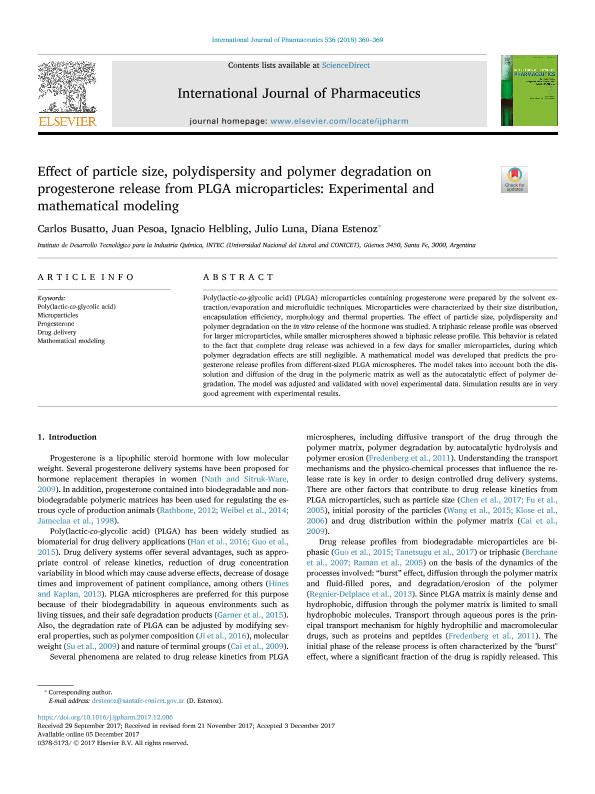Artículo
Effect of particle size, polydispersity and polymer degradation on progesterone release from PLGA microparticles: Experimental and mathematical modeling
Busatto, Carlos Alberto ; Pesoa, Juan Ignacio
; Pesoa, Juan Ignacio ; Helbling, Ignacio Marcelo
; Helbling, Ignacio Marcelo ; Luna, Julio Alberto
; Luna, Julio Alberto ; Estenoz, Diana Alejandra
; Estenoz, Diana Alejandra
 ; Pesoa, Juan Ignacio
; Pesoa, Juan Ignacio ; Helbling, Ignacio Marcelo
; Helbling, Ignacio Marcelo ; Luna, Julio Alberto
; Luna, Julio Alberto ; Estenoz, Diana Alejandra
; Estenoz, Diana Alejandra
Fecha de publicación:
12/2017
Editorial:
Elsevier Science
Revista:
International Journal Of Pharmaceutics
ISSN:
0378-5173
Idioma:
Inglés
Tipo de recurso:
Artículo publicado
Clasificación temática:
Resumen
Poly(lactic-co-glycolic acid) (PLGA) microparticles containing progesterone were prepared by the solvent extraction/evaporation and microfluidic techniques. Microparticles were characterized by their size distribution, encapsulation efficiency, morphology and thermal properties. The effect of particle size, polydispersity and polymer degradation on the in vitro release of the hormone was studied. A triphasic release profile was observed for larger microparticles, while smaller microspheres showed a biphasic release profile. This behavior is related to the fact that complete drug release was achieved in a few days for smaller microparticles, during which polymer degradation effects are still negligible. A mathematical model was developed that predicts the progesterone release profiles from different-sized PLGA microspheres. The model takes into account both the dissolution and diffusion of the drug in the polymeric matrix as well as the autocatalytic effect of polymer degradation. The model was adjusted and validated with novel experimental data. Simulation results are in very good agreement with experimental results.
Archivos asociados
Licencia
Identificadores
Colecciones
Articulos(INTEC)
Articulos de INST.DE DES.TECNOL.PARA LA IND.QUIMICA (I)
Articulos de INST.DE DES.TECNOL.PARA LA IND.QUIMICA (I)
Citación
Busatto, Carlos Alberto; Pesoa, Juan Ignacio; Helbling, Ignacio Marcelo; Luna, Julio Alberto; Estenoz, Diana Alejandra; Effect of particle size, polydispersity and polymer degradation on progesterone release from PLGA microparticles: Experimental and mathematical modeling; Elsevier Science; International Journal Of Pharmaceutics; 536; 1; 12-2017; 360-369
Compartir
Altmétricas



